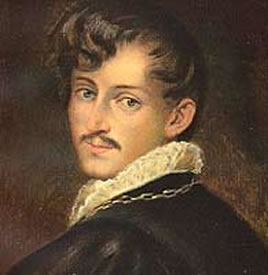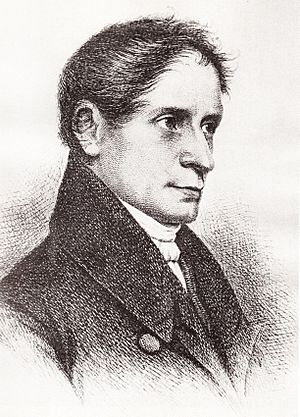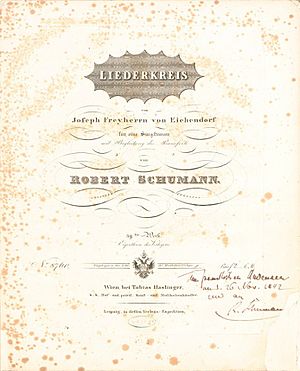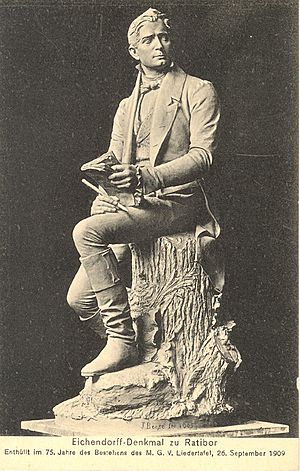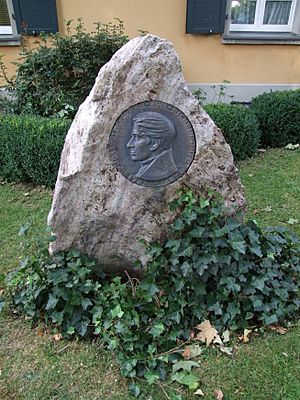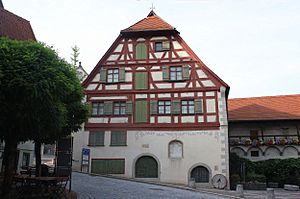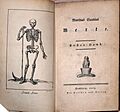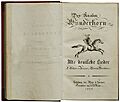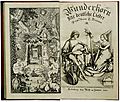Joseph Freiherr von Eichendorff facts for kids
Quick facts for kids
Joseph Freiherr von Eichendorff
|
|
|---|---|
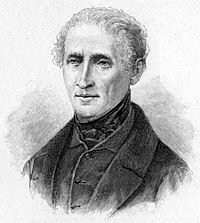 |
|
| Born | Joseph Karl Benedikt Freiherr (Baron) von Eichendorff 10 March 1788 Schloss Lubowitz (Polish: Pałac Eichendorffów) near Ratibor, Prussian Silesia, Kingdom of Prussia |
| Died | 26 November 1857 (aged 69) Neisse (Polish: Nysa), Prussian Silesia, Kingdom of Prussia |
| Occupation | Novelist, poet, essayist |
| Education | Heidelberg University |
| Period | 19th century |
| Genre | Novellas, fairy tales, poetry |
| Literary movement | Romanticism |
| Notable works | Memoirs of a Good-for-Nothing, The Marble Statue |

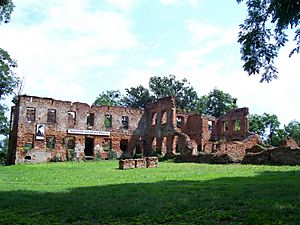
Joseph Freiherr von Eichendorff (born March 10, 1788 – died November 26, 1857) was a famous German poet and writer. He was one of the most important figures of the Romanticism movement. Many of his works, especially his poems, are still very popular in Germany today.
Eichendorff became well-known for his 1826 story Aus dem Leben eines Taugenichts (which means Memoirs of a Good-for-Nothing). This story is a classic example of Romantic writing. Its main ideas are the joy of travel and love.
The main character in Memoirs of a Good-for-Nothing is a miller's son. He leaves his father's work to become a gardener. He falls in love with the duke's daughter. Because he is from a lower social class, he thinks he cannot be with her. He travels to Italy. Later, he returns and finds out she is the duke's adopted daughter. This means they can be together.
This story mixes dreams with real life. It is seen as a highlight of Romantic fiction. One critic said Eichendorff's character shows a great "love of nature and an obsession with hiking." Many of Eichendorff's poems first appeared in his stories. Often, characters in his stories would sing these poems. His story Good-for-Nothing alone has 54 poems!
Contents
About Joseph Eichendorff
Early Life and Family
Joseph Eichendorff was born in 1788 at Lubowitz Castle. This castle was near Ratibor, which is now Racibórz in Poland. His family was old and noble. His father, Adolf Freiherr von Eichendorff, was a Prussian officer. His mother, Karoline, came from a Catholic noble family.
Joseph was very close to his older brother, Wilhelm. From 1793 to 1801, they were taught at home by a tutor. Joseph started writing diaries when he was just 10 years old. These diaries show how he began to become a writer. They included notes about the weather, family money, and his first poems.
School Days
From 1801 to 1804, Joseph and Wilhelm went to the Catholic Matthias Gymnasium in Breslau. Here, Joseph discovered the poems of Matthias Claudius. He also read La Henriade by Voltaire, an epic poem about French history.
In 1804, his sister Luise was born. After finishing school, both brothers attended lectures at the University of Breslau. Joseph's diary from this time shows he loved the theater. He went to many plays and concerts. He also developed a love for Mozart's music. Joseph was a good actor, and Wilhelm was a good singer and guitar player.
College and Travel
In 1805, Joseph and Wilhelm studied law and humanities in Halle. This city was a center for early Romantic writers. They often went to the theater to see plays by Goethe.
In 1806, Napoleon's army took Halle, and the university closed. So, in 1807, the brothers moved to the University of Heidelberg. Heidelberg was another important place for Romanticism. Here, Eichendorff met other Romantic poets like Otto Heinrich von Loeben and Achim von Arnim. He also heard lectures from Joseph Görres, a key figure in the Heidelberg Romantic group.
In 1808, the brothers finished their degrees. They then traveled to Paris, Vienna, and Berlin. In Berlin, they met more Romantic writers. In 1810, they went to Vienna to finish their studies. Wilhelm got a job in the government. Joseph went home to help his father manage the family estate.
Personal Life
Eichendorff's diaries tell us about his early crushes. One of his most famous poems, Das zerbrochene Ringlein (The Broken Ring), was inspired by a sad love story.
In 1809, Eichendorff became engaged to Aloysia von Larisch, called 'Luise'. She came from a noble but not wealthy family. They married in 1815. Their son Hermann was born that same year, and their daughter Therese in 1819.
Sadly, Eichendorff's family faced loss. His father died in 1818, and his mother in 1822. After his mother's death, the family lost all their estates. Also, like many families at that time, Eichendorff and Luise lost two of their daughters when they were very young. He wrote poems about this sadness.
A Life of Travel
Eichendorff's famous character, the Good-for-Nothing, is known for wandering. While Eichendorff wrote about wanderers, he himself didn't hike much. He traveled a lot for his work. He moved many times because of his government jobs. He traveled by coach or boat to many cities, including Prague, Paris, Vienna, Berlin, and Munich.
Government Work
Eichendorff worked for the Prussian government for many years. He started as a clerk in 1816. He became a chief administrator in Königsberg in 1824. In 1831, he moved his family to Berlin. He worked there for the Foreign Ministry until he retired in 1844.
Later Years and Death
Eichendorff's brother Wilhelm died in 1849. In 1855, Eichendorff was very sad when his wife, Luise, passed away. He died of pneumonia on November 26, 1857, in Neiße (Nysa). He was buried next to his wife the next day.
How Eichendorff Became a Romantic Writer
Artistic Inspirations
Two writers greatly shaped Eichendorff's writing style: Friedrich Schlegel and Joseph Görres. These writers were part of the Romantic movement in Germany. They believed in the importance of feelings, imagination, and personal experiences. They thought that poetry and life should be connected.
Eichendorff believed that nature was like a "great picture book" from God. He also loved folk songs. The collection Des Knaben Wunderhorn (The Youth's Magic Horn) by Achim von Arnim and Clemens Brentano was very important to him. This book was a collection of old German songs about love, soldiers, and traveling. It greatly influenced Eichendorff's own poetry.
Eichendorff’s Writing Style
Simple Words with Deep Meaning
Eichendorff's poems often use simple words, like those found in folk songs. But he adds deeper meaning to these words. His words are "rich in imaginative appeal and in sound."
Magic Words
Eichendorff often used special phrases or images. One famous idea he used was the Zauberwort (magic word). He believed that nature has a wonderful song hidden inside everything. The poet's job is to "wake up" this song with the right words.
One of his most famous poems, Wünschelrute (Divining Rod), is about finding this magic word:
|
Wünschelrute Schläft ein Lied in allen Dingen, |
Wishing Wand (There) sleeps a Song in all things |
Published Works
Eichendorff wrote many different types of works:
Poetry Collections
- Poems (1808)
- Poems by Joseph Freiherr von Eichendorff (1837)
- Julian, a story in verses (1853)
- Robert und Guiscard, an epic poem (1855)
- Lucius, an epic poem (1855)
Novels
- Ahnung und Gegenwart (Foreboding and Present) (1815)
- Dichter und ihre Gesellen (Poets and Their Companions) (1834)
Novellas (Short Novels)
- Die Zauberei im Herbste (The Magic in Autumn) (published 1906)
- Das Marmorbild (The Marble Statue) (1819)
- Aus dem Leben eines Taugenichts (Memoirs of a Good-for-Nothing) (1826)
- Viel Lärmen um Nichts (Much Ado About Nothing) (1833)
- Eine Meerfahrt (A Sea Voyage) (1836)
- Das Schloß Dürande (Dürande Castle) (1837)
- Die Entführung (The Abduction) (1839)
- Die Glücksritter (The Knights of Fortune) (1841)
- Libertas und ihre Freier (Libertas and Her Suitors) (1848)
Plays
- Krieg den Philistern! (War on the Philistines!) (1823)
- Meierbeth's Glück und Ende (Meierbeth's Fortune and End) (1827)
- Ezelin von Romano (1828)
- Der letzte Held von Marienburg (The Last Hero of Marienburg) (1830)
- Die Freier (The Suitors) (1833)
Translations
Eichendorff also translated works from Spanish:
- Pedro Calderón de la Barca: Der Graf Lucanor (Count Lucanor) (1845)
- Die geistlichen Schauspiele Calderons (Calderon's Spiritual Plays) (1846–53)
Literary Criticism
He wrote essays about literature, such as:
- On the ethical and religious significance of the new romantic poetry in Germany (1847)
- The German novel of the 18th century in its relationship to Christianity (1851)
- History of German poetic literature (1857)
Other Works
- Upper Silesian fairytales and sagas (1808–1810) - as an anthologist (collector)
- Edited Gedichte (Poems) by Lebrecht Blücher Dreves (1849)
Music Inspired by Eichendorff

Eichendorff is one of the most popular German poets for music. About 5000 songs have been made using his poems! People say his poems sound like music already. Many famous composers set his poems to music. These include Schumann, Mendelssohn, Johannes Brahms, Hugo Wolf, and even Friedrich Nietzsche.
His poems also inspired larger musical pieces. For example, Reger's Eine romantische Suite and electronic music by Qntal.

Museums and Organizations
If you want to learn more about Joseph von Eichendorff, you can visit:
- Deutsches Eichendorff-Museum in Wangen im Allgäu, Germany.
- Frankfurter Goethe-Haus in Frankfurt am Main, Germany.
- Eichendorff-Forum at the University of Regensburg.
Images for kids
-
Cave in the Harz Mountains, Caspar David Friedrich, sepia, ca. 1811
-
Eichendorff residence in Köthen, 1855
-
Josef Görres by August Strixner, lithograph (after a painting by Peter von Cornelius)
See also
 In Spanish: Joseph von Eichendorff para niños
In Spanish: Joseph von Eichendorff para niños


